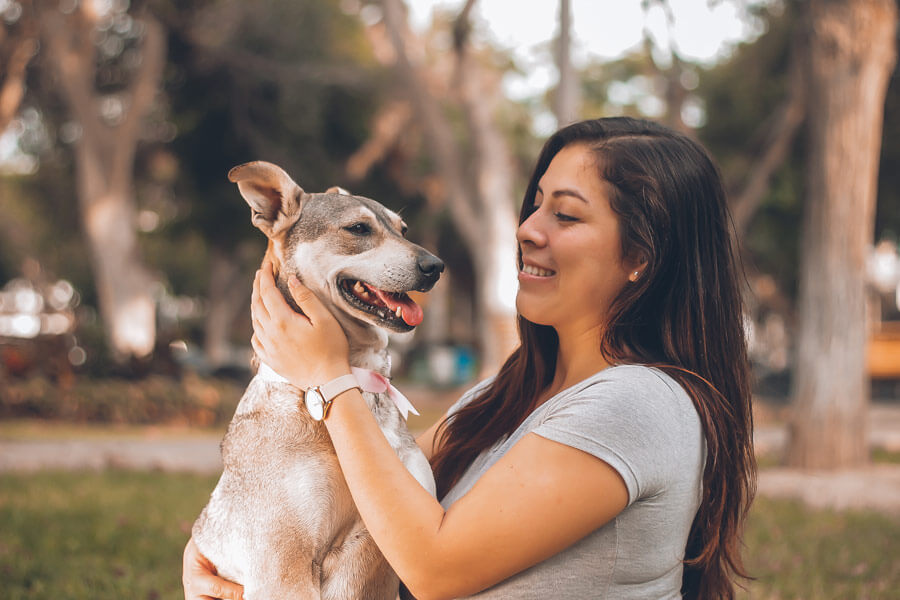Just like humans, dogs can experience feelings of anxiety for various reasons. It’s important for pet professionals to assist pet owners to recognise the signs and identify potential causes.
There are many different types of anxiety but possibly the most common anxiety in dogs is separation anxiety.
According to the American Kennel Club dog anxiety can affect all breeds and while it’s something that most dogs will experience at one time or another, dog anxiety can be detrimental to the animal’s health.
It states, ‘if disproportionate levels of anxiety are left unchecked, a dog can develop an anxiety disorder. If left untreated, anxiety can lead to behavioral and other issues.’
Therefore, helping clients to recognise the signs and advising on how to treat dog anxiety can help address the issue early.

Signs of dog anxiety
There are recognisable signs and symptoms to indicate a dog is feeling stressed or anxious. Potential cues include:
- Excessive barking
- Howling
- This might include pacing or panting (even when it’s not hot)
- Destructive behaviour
- Aggressive behaviour
- Shivering or cowering
- Digging or frequently escaping
- Excessive licking or chewing
- Urinating or defecating in the house despite being well trained
While some of these indicators may be dismissed as ‘normal’ behaviour, it’s important for pet owners to be aware of the common signs of dog anxiety.
Overlooking or simply not recognising the signs of dog anxiety means that no action will be taken to address the issue. The longer a dog suffers anxiety, the more likely the problem will grow.
Dog anxiety: causes
Of course, being aware of common causes of dog anxiety can help pet owners to avoid such situations or triggers.
According to the Merck Veterinary Manual, separation and fear are common causes of anxiety in dogs.
In particular, separation anxiety affects approximately 14% of dogs and can present as a result of changing circumstances, for example, a change in household routine.
The negative behaviour associated with separation anxiety usually presents within the first 15-30 minutes after the dog is separated from the family. As such, dogs that suffer from separation anxiety can start to display signs as the owner prepares to leave the house.
Dogs are pretty clever and astute beings. They recognise that putting on shoes, wearing a coat, picking up keys and approaching the door are signs of impending separation.
The Veterinary Manual states: ‘When the owner is home, the dog may crave constant contact or proximity to the owner. When the owner returns, the welcoming responses are commonly exaggerated and the dog is hard to calm down.’

Reducing dog anxiety
Aside from medicine, there are other ways to help minimise a dog’s anxiety. Pet owners can plan and prepare for when they are not going to be at home. A pet sitter can be a useful resource, as can doggy daycare.
In addition, ensuring the dog has regular exercise and has a safe and secure area in the home can help alleviate separation anxiety and encourage the pet to feel safe when the owner is not around.
Another way to address anxiety in dogs is behavioural training. Encourage pet owners to give their dog something they love or enjoy doing just before they leave the house. For example, they might give the dog a toy it loves that will keep it occupied for a while or a treat to chew on.
It might be helpful for the pet owner to contact a professional dog trainer or an animal behaviourist, to introduce strategies such as counter-conditioning or desensitization.
Treating dog anxiety with medication
The other option for treating dog anxiety is using medication. This might be particularly useful for dogs that have developed a serious disorder.
The most common medicines used to treat anxiety in dogs are selective serotonin reuptake inhibitors (SSRIs) and tricyclic antidepressants (TCAs). In cases where the anxiety-causing trigger is known (such as thunderstorm, noise or the owner leaving), a benzodiazepine can be given alongside an antidepressant up to 1 hr before the event.
The Veterinary Manual adds that natural therapies can also be used alone or in combination with other drugs. It says that while there is limited evidence to support the efficacy of natural products, there are studies to support the use of Adaptil.
However, it’s important to be aware that medicines are not necessarily addressing the underlying condition; they are merely reducing the symptoms. Talk to pet owners about what they feel is the best approach for their pet.
Other posts you might be interested in:
Latest posts by Liz Walden (see all)
- Pet health: Medicinal cannabis for pets - December 27, 2021
- What pet business insurance do I need? - November 17, 2021
- Pet sitters: how to take time off - November 15, 2021










Leave A Comment